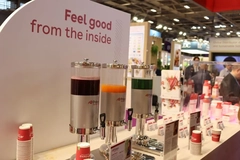Danish researchers discover gently heating lactic acid bacteria produces vitamin B2

Many vitamins are produced in chemical factories, often synthetically, but scientists at the Technical University of Denmark have succeeded in developing a natural and simple method for producing vitamin B2 (riboflavin) — by gently heating lactic acid bacteria. It produces significant quantities in a cost-effective and climate-friendly method, they highlight.
The researchers say this could be a game-changer in developing countries, where many suffer from vitamin B2 deficiency, enabling fortification with B2 directly in local kitchens.
“I think it’s beautiful that something as simple as gentle heating and lactic acid bacteria can be used to produce vitamin B2. The method allows for food to be fortified with vitamin B2 in an easy way, for example, during the production of yogurt or sourdough,” says associate professor Christian Solem from DTU National Food Institute, who led the research.
Currently, most vitamins are produced in factories, either synthetically or with the help of microorganisms that are not approved for food use. The researchers highlight these production methods often require extensive and complex purification processes — to separate the vitamin from non-food-approved materials — which are costly and energy-intensive.
Harnessing nature’s biofactories
Vitamin B2 is essential for energy production and for maintaining a normal immune function. It also plays an important role in iron absorption and deficiency has wide-ranging effects.
The team subjected lactic acid bacteria to “oxidative stress,” a natural pressure that compels bacteria to produce more riboflavin to protect themselves.
“We used the microorganism Lactococcus lactis, commonly known from cheese and cultured milk, to produce vitamin B2,” explains Christian Solem.
“Lactococcus thrives best at around 30°C, but we heated the bacteria to 38–39°C, which they didn’t like. Bacteria adapt to new conditions, and to defend themselves against the oxidative stress caused by the heat, they start producing vitamin B2.”
The researchers optimized the vitamin production process by adding various nutrients, achieving a production of 65 mg of vitamin B2 per liter of fermented substrate — nearly 60 times the daily human requirement for the vitamin.
Cultural compatibility and future potential
The new method integrates vitamin production into the food fermentation process. “When these foods are fermented using the starter culture, which includes specially selected lactic acid bacteria along with traditional ones, they automatically produce riboflavin while maintaining the traditional flavor and texture of the food,” says Solem.
“It would be ideal to package these B2-producing lactic acid bacteria as a starter culture that can be added to foods like milk, maize or cassava for fermentation.”
The method could potentially be expanded to produce other essential vitamins and nutrients, such as folic acid (B9) and vitamin B12, which are often lacking in plant-based diets. It could also be applied to various food types, including sauerkraut.
Many developing countries already have strong traditions of fermenting foods, which extend shelf life and reduce waste.
The method differs from existing technologies by being natural — without genetic modification — and consuming less energy and fewer chemicals compared to traditional synthetic vitamin production. Fortification only requires basic fermentation tools, which are already common in many households.
Taking food fortification forward
Food fortification remains at the top of mind, particularly among policymakers in developing nations working together with the private sector. Among notable actors, Millers for Nutrition is a coalition of helping millers fortify staple foods. The coalition supports millers in Bangladesh, Ethiopia, India, Indonesia, Kenya, Nigeria, Pakistan and Tanzania in fortifying wheat and maize flours, edible oil and rice.
Fortification deliberately adds micronutrients (vitamins and minerals) to commonly consumed food to improve its nutritional quality, playing a central role in national health policies. In the UK, for instance, millers and flour producers must fortify non-wholemeal wheat flour with folic acid by the end of 2026 to protect newborn babies from severe brain and spine problems.
Among innovative food fortification launches this year, Rohto Pharmaceuticals and dsm-firmenich recently announced the Japanese debut of Vision R — multi-layered micronutrient granules designed to address nutritional insufficiencies among seniors, which can be “seamlessly integrated” into food. The food-fortifying ingredient utilizes dsm-firmenich’s patented Sprinkle It Technology.
With vitamin A being essential for the development and maintenance of healthy vision in infants, dsm-firmenich also released a “breakthrough” dry form of vitamin A designed to enrich baby formula nutrition without the stability issues associated with traditional vitamin A ingredients.












